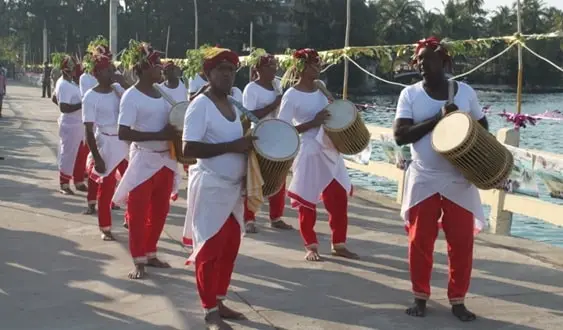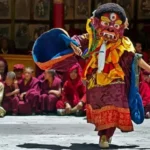The famous archipelago of India, located by the Arabian Sea, the great Lakshadweep bores many surprises for the art enthusiasts. The cultural heritage and traditions that Lakshadweep carries, are unique in their expressions. The cultural expressions and the tales of the land comes alive through the dances. Lakshadweep stands as the abode of artistic expressions imbued with the history of the land with these dance forms. Here we will discuss in brief about them.
The Essence of Lakshadweep Dances:
Lakshadweep dances represent the islanders’ rich past. This dance represents the islands and is essential in cultural, religious, and social activities. They dynamically depict communal joy and festivity. These rhythms are more than brilliant performances—they embody Lakshadweep’s culture. Islanders express camaraderie and pride in every exquisite dance and passionate beat, passing on their tradition. The vibrant traditional dances showcase this beautiful island’s rich culture.
1. Lava Dance: A Mesmerizing Display of Grace:

Lakshadweep’s culture revolves on the Lava dance, a spectacular rhythmic performance. ‘Lava’ derives from ‘Lavani,’ meaning beauty, and the dance is a gorgeous exhibition of vibrant steps and lovely costumes. The Lava dance, usually performed by women, is a mesmerizing mix of swinging hips, delicate hand gestures, and clever footwork. The dancers’ traditional jewelry and exquisite costumes add to the performance’s visual appeal and reflect the island’s culture. The Lava dance is more than simply art—it celebrates the islanders’ joy and camaraderie. This lovely dancing form symbolizes Lakshadweep’s communal spirit and festival joy. Traditional music accentuates Lava dancing. Rabab and Thavil tunes accompany the dance. The dancers’ movements are accentuated by the rhythmic and lyrical soundtrack. The Lava dance and music provide a sensory experience that embodies the island’s culture beyond entertainment. Beauty, culture, and Lava dance maintain Lakshadweep’s history. This dancing technique has linked the island’s history and present for years, safeguarding its traditions from modern influences. The Lava dance tells Lakshadweep’s story via graceful movement.
2. Parichakali: A Martial Dance Celebrating Valor:
A fascinating and historically important Lakshadweep martial art dance form is Parichakali. Self-defense turned into a magnificent and traditional dance featuring martial arts, rhythmic footwork, and bright costumes. Parichakali, usually a man, tells the story of ancient warriors’ prowess with every step. The dance honors decades of bravery using swords and shields. The dancers’ intricate patterns and synchronized moves celebrate the islands’ naval past. Lakshadweep’s heroic and enduring legends are told in each sword swing and rhythmic dance. This martial dance benefits from traditional drums and cymbals. Beats energize Parichakali onstage. It makes a dance a vivid celebration of courage and heritage, thrilling the audience and connecting them to the island’s past. Parichakali preserves Lakshadweep’s martial history beyond entertainment. Survival depended on the islanders’ combat abilities, which the dance celebrates.
3. Dandiyya Raas: A Fusion of Devotion and Celebration:
Gujarati Dandiyya Raas has adapted to Lakshadweep’s vibrant culture. This old dancing technique is rhythmic and beautiful with colorful dandiyas. Gujarati-inspired Dandiyya Raas has adapted to Lakshadweep’s local food and culture. The dance symbolizes good triumphing over evil and is performed at religious festivals, weddings, and other celebratory occasions. With dancers in island attire, Lakshadweep’s Dandiyya Raas is stunning. Local materials demonstrate the islanders’ cultural preservation efforts. Lakshadweep’s Dandiyya Raas has a distinct style and bright dandiyas. With their particular manner, dancers provide island flair to the presentation. Loud music and dandiya fights enliven the area. Dance bonds people throughout these ceremonies. Dandiyya Raas in Lakshadweep goes beyond a traditional dance to express the islanders’ joy. The dance’s rhythmic beats and dandiyas merge to represent community and life’s accomplishments. More than a show, it brings together cultures and pleasures across boundaries.
4. Kolkali: A Traditional Group Dance of Unity:
Kolkali is a cherished Lakshadweep traditional tradition that symbolizes togetherness and pleasure. The rhythmic and synchronized group dance involves hitting neighbors’ sticks with two sticks in a circle. The result is a captivating Lakshadweep-inspired dance and music. Kolkali, an island dance, signifies cooperation and teamwork. The circle symbolizes community, and when sticks hit a rhythm, the space becomes collaborative. This dance represents islanders’ joy and unity, not just a display. Kolkali comes alive at religious and social events. Participants and spectators bond via dance. The footwork and rhythms immerse you in Lakshadweep’s culture. Kolkali is essential for cultural transmission and pleasure. This dance retains Lakshadweep’s tradition with each stick stroke and synchronized step. Kolkali, handed down from generation to generation, displays islanders’ cultural preservation.
5. Sparshamani: A Soulful Dance of Devotion:
Lakshadweep’s spiritual heritage is Sparshamani, an ethereal dance with religious significance. The phrase means ‘diamond of touch,’ referring to a spiritual dance. At temples and religious rites, Sparshamani is a particular dedication that fosters reverence and spirituality. Dancers wear white to represent purity and commitment. Sparshamani’s slow, rhythmic movements are reverent. This meditation and devotional dance transcends earthly boundaries with each step. Sparshamani’s ethereal choreography lets dancers connect with the sacred via subtle gestures. Each dance move conveys religious conviction as artists seek spiritual unity. Gradual, focused motions connect the soul to Lakshadweep’s celestial elements.
Conclusion:
By the side of the Arabian Sea, Lakshadweep holds a very special place for those who are lovers of dance. The dance performances are mostly done during the festivals or rituals. The people of this island are keen on performing these dances with all their vigor and perfection. For the islanders such dance performances are quite special
Santosh Kumar, the author behind IndiasStuffs.com, is passionate about sharing valuable insights on a variety of topics, including lifestyle, technology, and Indian culture.
Page Contents

